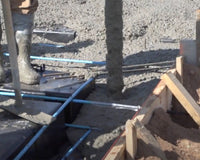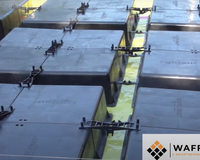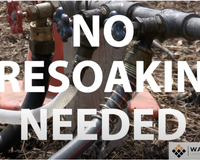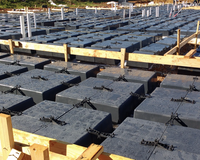Every new build or addition must start with a strong foundation. The stability of a strong foundation relies on the soil beneath it. To ensure the soil on your build site has ideal properties for concrete slab support, it is common practice for contractors to haul in new soil to be used as “fill”.
Fill dirt -also known as fill- is a type of dirt that’s used to create a sturdy base to support a concrete foundation. Bringing in fill dirt is not always necessary; with the right foundation system, it is possible to use the native soil that already exists onsite as the subgrade for your structure.
The Basics: Native Soil vs. Select Fill

Native soil is the soil that is originally present on an untouched building site. This means that the soil that has not been previously disturbed and matches the properties of other soils in the local area. The qualities of native soils might not always be favorable for building, and they vary distinctively from region to region.
If the conditions are not favorable for construction, the project will require some subgrade preparation for concrete slabs. To achieve this, select fill or “fill dirt” is brought onsite. This soil is brought to the site for its desirable properties. Typically select fill will include granular materials like sand, gravel, or crushed stone that provides the strength and permeability that is ideal for slab-on-grade projects.
Why Is "Fill Dirt" Often Used in Construction?

Expansive soils are defined as any soils that expand and shrink depending on the presence of water. The use of expansive dirt under a concrete slab can be a big cause for concern. When these soils expand and shrink, they create movement that cause stress to the concrete slab above them. This differential movement of soils is one of the most common causes of serious structural damage.
If the native soils onsite exhibit these less-than-desirable traits, they are removed and replaced with select fill. “Fill dirt” will be free draining; meaning that it will not retain water, therefore cannot expand and contract below your concrete slab, causing foundation failure.
On hauling of select fill does improve the conditions of the site, but it adds significant costs to the project that add up quick. There will be added cost for excavating, hauling, and disposing of the existing native soils along with purchasing and installing the new select fill.
These costs can add up to $25/SF depending on the severity and size of the site! Not to mention the time spent searching for quality select fill material in the quantity that is needed for the project.
Can You Use Native Dirt Under Concrete Slab?

It is possible to avoid these costs and to utilize the existing site soil beneath your foundation.
In certain regions, the soils are ideal, free-draining, and fine aggregate, and only require evening-out. In this case, there is no need to haul in select fill. However, what about non-ideal scenarios? Can we avoid the cost of hauling in select fill?
The best way to avoid the need for fill soil is by choosing a concrete foundation solution that is designed to accommodate for less-ideal soil types.
Using a foundation system that can accommodate expansive soil conditions, like the Wafflemat Foundation System, is your best option. This system utilizes structured voids beneath your foundation slab that provide the expansive soil a pocket to expand into. Since the expansive soils under this foundation have a place to go, they will not be stressing the slab nor cause any structural failures.
Sometimes the best fill for a concrete slab is the type that will cost you nothing – no fill at all.
Instead of paying for select fill for your build site, choose a foundation system that will work with the soil that is already there. This method benefits the overall cost and turnaround time of your project, and it removes the need to locate offsite fill soil that can be difficult to find in the quality and quantity needed.
Stop Paying for Select Fill with the Wafflemat Foundation System

The Wafflemat Foundation System is designed to accommodate expansive soils. Also known as a ribbed slab foundation, this foundation can be installed in “subpar” native soil conditions including expansive, rocky, or hydro-collapsible soils without the need for any fill dirt!
The signature difference in a Wafflemat foundation are the void forms. Void forms are placed above the native soils after subgrade preparation for concrete slab in a grid pattern. The forms are secured with patented brackets that double as a connection point for post tension cables. These void forms are made of plastic boxes ensuring their integrity for years to come.
Once the void forms are properly installed, concrete is poured directly over the forms to create your slab. The void space in the forms allows the native soils to expand beneath the slab without disrupting the resting location of your foundation. If soil moves beneath a concrete slab without this system in place, your building will be subject to structural failures including cracks in walls and floors, jammed doors and windows, or irreparable foundation damage.
After a Wafflemat system is installed, it will appear exactly like a traditional slab-on-grade concrete foundation with the only notable difference in time and cost savings. Wafflemat can result in savings of up to 20% on concrete and steel materials. The Wafflemat Foundation System is used in both residential and commercial applications.
If you’re a developer looking to save time and money by cutting out the need for select fill dirt on your construction sites, you need to check out Wafflemat.
Since 1993, Wafflemat has been used in over 30,000,000 square feet of foundations across America without a single structural failure, proving its effectiveness against expansive and rocky soil conditions.
For more details on how the Wafflemat Foundation System will work for your project, please fill out the form on this page!

Written By: Brionna Marie
Brionna has a B.S. in Civil Engineering from Clarkson University and several years of design and construction experience serving both public and private clients. Today, she utilizes her industry knowledge to conduct research and write technical articles across a variety of civil engineering topics.





